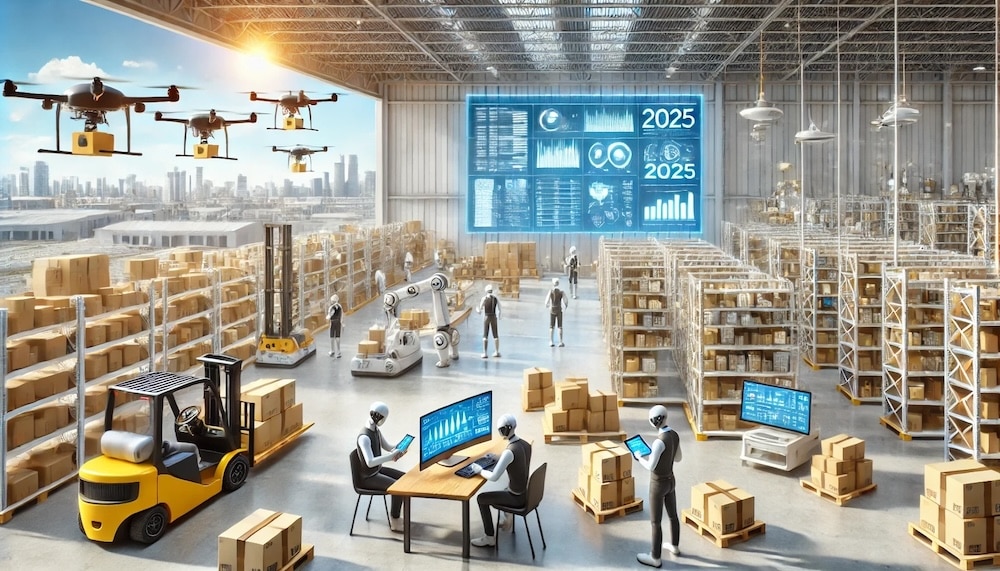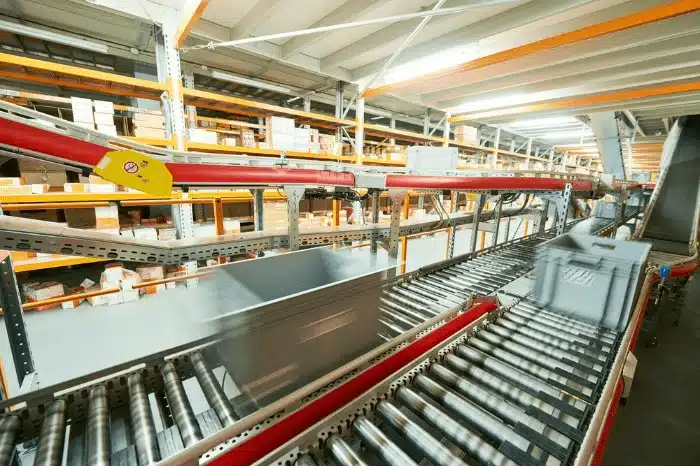
As we move into 2025, the third-party logistics (3PL) industry is undergoing rapid transformation, driven by eCommerce expansion, advanced technologies, and heightened customer expectations. Staying updated on these changes is essential for 3PL providers to remain competitive and meet the demands of an increasingly complex global supply chain. This article explores the key trends set to shape the 3PL and warehouse management landscape in 2025, providing insights to help your business stay ahead.
Growth of eCommerce, Adapting Fulfillment Strategies, and Expansion of FaaS Offerings
The unstoppable growth of eCommerce is set to continue through 2025, with retail sales projected to increase globally. To keep pace, 3PLs must expand their fulfillment networks, optimize warehouse space, and adopt advanced automation solutions. Efficiently managing inventory and fulfilling orders across multiple channels—including major online marketplaces and emerging niche platforms—remains crucial for 3PLs operating in today’s global supply chains.
Fulfillment-as-a-Service (FaaS) has become essential for businesses seeking flexible, scalable, and cost-effective fulfillment options. In 2025, FaaS will be even more integral to logistics, with refined processes and technology-enabled order picking and packing. By embracing FaaS, 3PL providers can enhance operational efficiency and adapt to evolving eCommerce demands, positioning themselves as invaluable partners in the online retail ecosystem.
Addressing Labor Shortages with Training and Automation
Labor shortages have continued to challenge the logistics industry, and in 2025, 3PL providers must address this by combining workforce upskilling with advanced automation. By investing in employee training programs and offering opportunities for upskilling, logistics companies can retain talent and equip their workforce with the necessary skills for an increasingly digitalized industry.
Automation remains a critical tool to alleviate labor pressures, minimizing reliance on manual labor for repetitive tasks like data entry, inventory management, and order fulfillment. Additionally, artificial intelligence now plays a larger role in optimizing workflows, using predictive analytics to allocate resources effectively and maintain operational continuity even during labor fluctuations.

Embracing Automation, Reducing Manual Data Entry, and Leveraging Predictive Analytics
Automation and technology integration are reshaping the third-party logistics industry in 2025, making it possible for 3PLs to streamline operations, lower labor costs, and maintain a competitive edge. Innovations such as warehouse automation, autonomous vehicles, and IoT-connected devices are now mainstream, enabling faster, more accurate processes that meet the demands of today’s logistics environment.
Reducing manual data entry through automation saves time and minimizes errors, allowing 3PLs to focus resources where they’re needed most. Furthermore, predictive analytics has advanced significantly, helping 3PL providers use historical data to forecast demand, optimize warehouse space, and make data-driven decisions that improve both efficiency and service levels.
Last-Mile Delivery Innovations
In 2025, last-mile delivery remains a critical focus for logistics providers, driven by consumer demand for faster and more flexible delivery options. New advancements, including autonomous delivery vehicles, drones, and electric fleets, are becoming more prevalent, helping 3PLs minimize delivery times, lower their carbon footprint, and reduce operating costs. These technologies are also crucial for supporting international logistics, allowing 3PLs to manage deliveries efficiently across global markets where fast shipping is a competitive differentiator.
As last-mile innovations become more accessible, 3PLs gain the tools to enhance their service offerings and adapt to the rising expectations of both consumers and business clients, making efficient last-mile solutions a must for logistics providers in 2025.
Greener Supply Chains and Sustainable Practices
With environmental awareness on the rise, greener supply chains have become a central priority for the 3PL industry in 2025. Logistics companies are increasingly adopting sustainable practices, such as using renewable energy, optimizing transportation to cut emissions, and implementing waste-reduction initiatives across their operations. Meeting environmental standards isn’t just a regulatory requirement; it’s a competitive advantage as customers and business partners seek eco-friendly logistics solutions.
Sustainability efforts, from reducing energy consumption to integrating carbon-neutral shipping options, are essential in 2025’s logistics landscape, where consumer and client expectations are pushing for meaningful environmental responsibility from their supply chain partners.
Focus on Customer Experience and Personalization
As competition in the logistics industry heats up in 2025, customer experience has become a defining factor for success among 3PL providers. Logistics companies are leveraging advanced technologies to personalize services, tailor delivery options, and provide real-time tracking and updates that meet the high expectations of today’s clients. In a market where timely and accurate service is paramount, personalization becomes a key differentiator.
Exceptional customer experience now goes beyond timely delivery—it includes transparency, customized service options, and responsiveness to individual client needs. As 3PLs prioritize these aspects, they strengthen customer loyalty and enhance their brand reputation, positioning themselves as providers who go the extra mile.
Related: Top Challenges Facing 3PL Warehousing Providers and How to Overcome Them
Real-time Visibility, Transparency, and Increased Collaboration in Supply Chain Management
In 2025, real-time visibility and transparency are critical components of effective logistics operations. As businesses and consumers demand more control and insight into their supply chains, 3PL providers must invest in advanced tracking systems, IoT devices, and real-time data collection technologies to offer precise updates on shipment status, inventory levels, and delivery timelines. These enhancements not only improve customer satisfaction but also enable logistics providers to streamline operations and make data-informed adjustments swiftly, meeting the growing demands of sectors like retail, healthcare, and manufacturing.
Efficient supply chain management also hinges on increased collaboration across the logistics ecosystem. By adopting digital platforms and automation technologies that support real-time communication and data sharing, 3PLs in 2025 can enhance transparency, reduce response times, and foster stronger partnerships with stakeholders. This collaborative approach is essential for optimizing the supply chain and improving resilience in today’s interconnected global market.

Customized Solutions and Niche Market Specialization
The 3PL landscape in 2025 is marked by an increasing demand for customized solutions tailored to specific industries and business needs. As logistics providers strive to differentiate themselves, many are specializing in niche markets such as healthcare logistics, perishable goods, and reverse logistics. By focusing on these specialized areas, 3PLs can deliver targeted expertise and solutions that meet the exacting standards of each industry, from temperature-controlled environments for perishables to compliance-driven handling for medical supplies.
This trend toward niche specialization allows 3PL providers to build stronger client relationships, attract new customers in specialized sectors, and remain competitive by offering services that general providers may not be equipped to deliver. In 2025, customization and market specialization are powerful strategies for 3PLs aiming to establish a distinctive market presence.
The Growth of Other Online Marketplaces
As eCommerce continues to expand in 2025, a growing number of specialized online marketplaces are emerging alongside giants like Amazon and eBay. These niche platforms serve specific industries or unique product categories, providing 3PLs with fresh opportunities to reach new audiences and expand service offerings. By partnering with these smaller marketplaces, 3PLs can develop tailored solutions, meet the specialized logistics needs of each platform, and tap into high-margin business segments.
For 3PL providers, this shift represents a chance to diversify revenue streams and build stronger, more strategic partnerships within the eCommerce ecosystem. As these marketplaces gain traction, they are driving new growth opportunities for logistics providers poised to offer agile, adaptable services that cater to emerging online retail trends.
Amazon Sellers and the Role of Third-Party Logistics Providers
With the continued popularity of Amazon as a selling platform in 2025, the demand for third-party logistics providers who can support Amazon sellers has never been higher. 3PLs are increasingly offering specialized services tailored to the unique requirements of Amazon, including inventory management, storage, and fulfillment services optimized for Amazon’s marketplace standards. These solutions enable sellers to streamline their operations, lower fulfillment costs, and enhance customer satisfaction by meeting Amazon’s fast-shipping expectations.
By catering to Amazon sellers, 3PLs position themselves as vital partners in the eCommerce landscape, helping businesses of all sizes leverage the platform’s reach while maintaining operational efficiency. As Amazon continues to dominate the online retail market, 3PL providers offering these specialized services will remain highly competitive and integral to the success of countless Amazon-based businesses.
Revenue Growth Through More Opportunities
In 2025, capitalizing on industry trends is key to growth and sustained success in the 3PL sector. Third-party logistics providers can drive revenue growth by diversifying their service offerings, exploring new markets, and leveraging emerging technologies. Expanding into specialized sectors or forming partnerships with innovative online marketplaces allows 3PLs to reach new customer bases and adapt to shifting demand.
To stay competitive, 3PLs must remain agile, continually seeking ways to optimize operations and enhance their service portfolio. By embracing new opportunities and evolving with industry trends, logistics companies can strengthen their market position and achieve long-term revenue growth in an increasingly competitive landscape.
Related: 3PL Best Practices: Tips for Third-Party Logistics Providers
Logimax: A Game-Changer for 3PL and Logistics Companies
Logimax offers a state-of-the-art warehouse management software solution designed specifically to meet the evolving needs of 3PL providers in 2025. With advanced features and capabilities, Logimax empowers logistics companies to streamline operations, increase efficiency, and deliver exceptional customer satisfaction in a highly competitive industry.
Our platform enables 3PL providers to automate essential warehouse processes, reduce manual tasks, and gain real-time visibility across inventory and fulfillment operations. These insights support data-driven decisions that enhance performance, optimize resource allocation, and improve operational resilience.
As the logistics landscape continues to shift, solutions like Logimax are indispensable for staying ahead of industry trends and seizing new opportunities. In 2025 and beyond, leveraging advanced software systems such as Logimax will be crucial for 3PL companies aiming to navigate complexities, adapt quickly, and achieve long-term success.
Conclusion
In 2025, staying ahead of 3PL industry trends is essential for logistics providers looking to thrive in a dynamic and competitive landscape. By embracing innovations in last-mile delivery, harnessing the power of data analytics and predictive tools, implementing sustainable practices, and prioritizing customer experience, 3PLs can remain competitive and drive growth. Addressing labor challenges, investing in automation, and offering customized solutions will further equip providers to meet client expectations and capitalize on new opportunities.
If you’re ready to enhance your logistics operations, consider Logimax—a powerful warehouse management solution that adapts to the demands of 2025’s fast-paced logistics industry. Contact us today to learn more about how our innovative solutions can drive your business forward in this evolving market.



